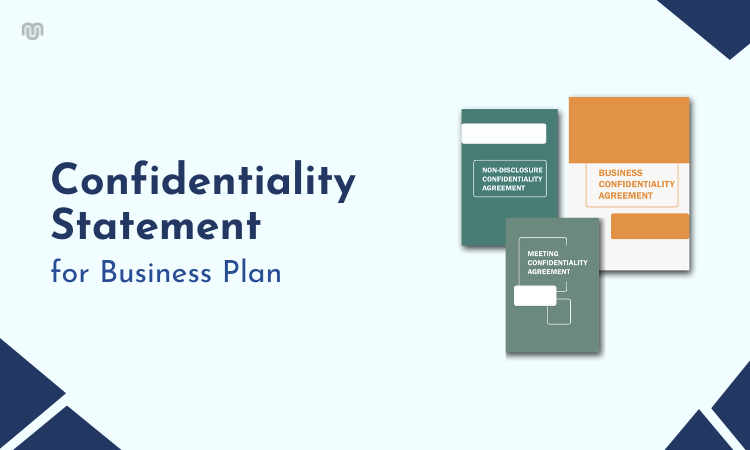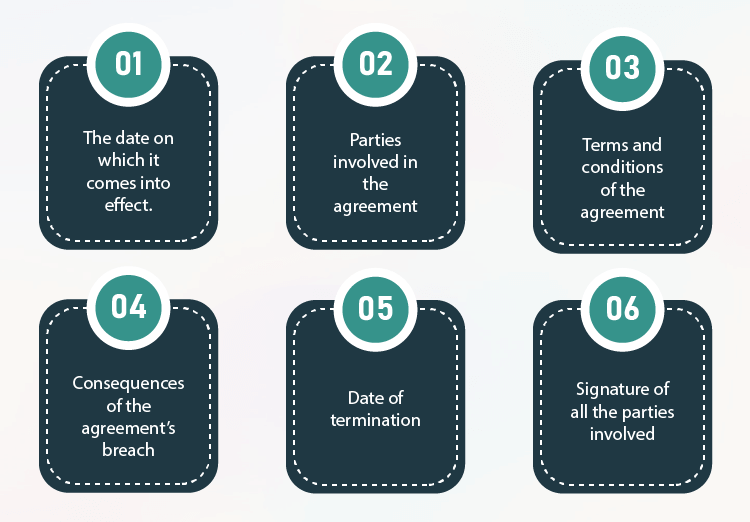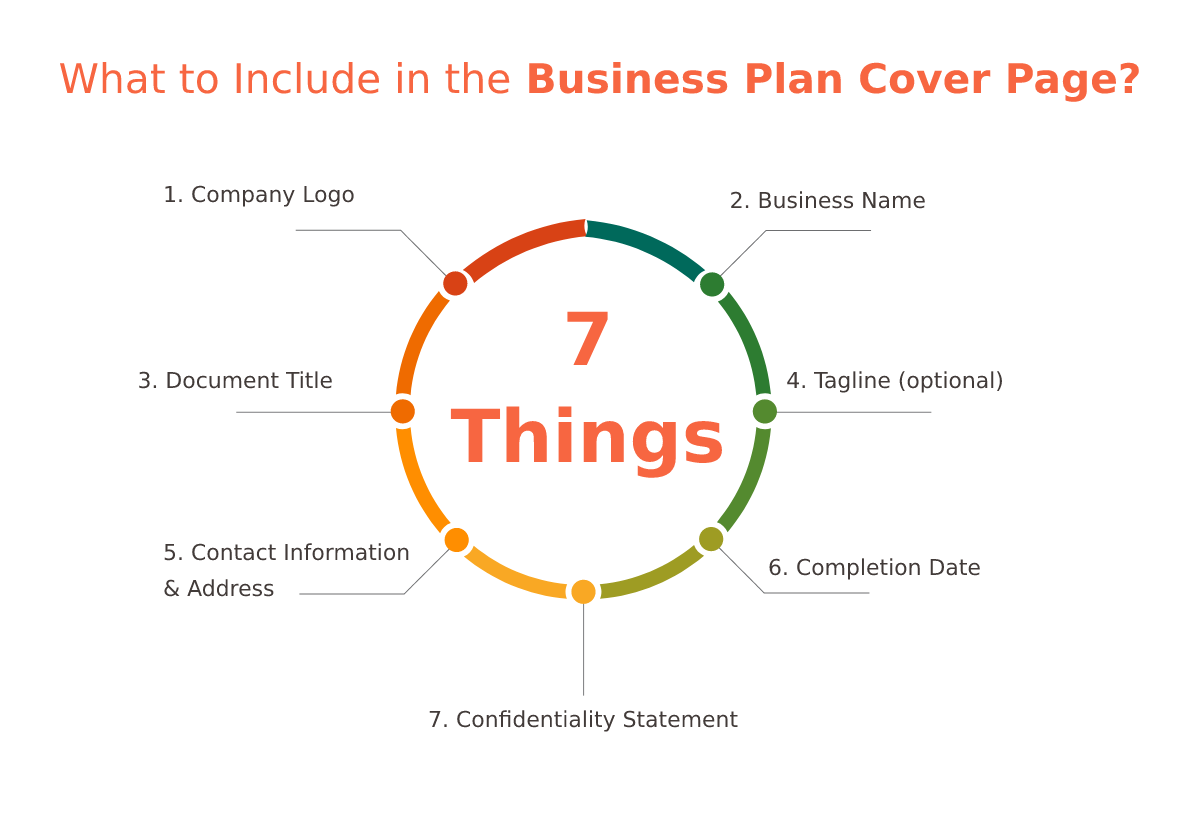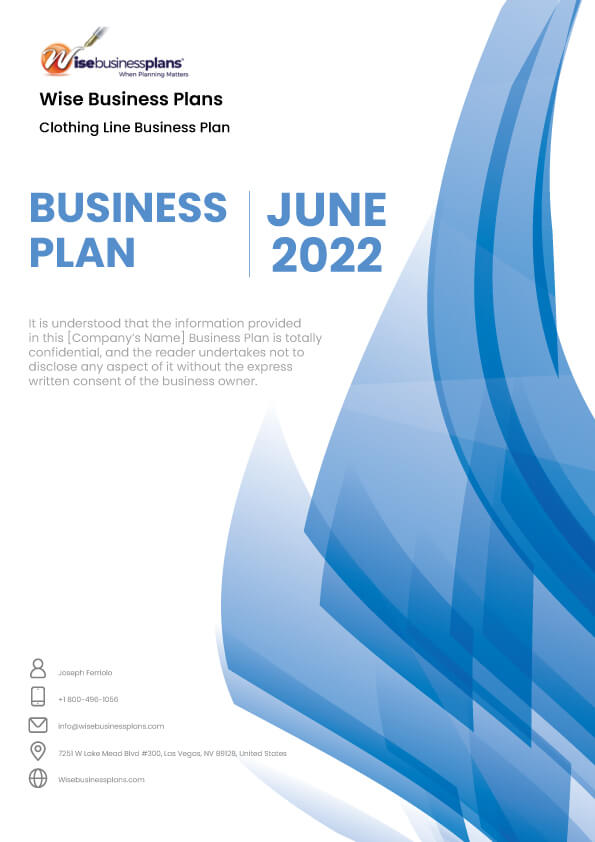Sign up for our newsletter for product updates, new blog posts, and the chance to be featured in our Small Business Spotlight!


How to write your business plan cover page
When you think of putting together your business plan , the business plan cover page may not be the first thing that comes to mind. While it’s traditionally one of the last sections you create in a business plan, it’s one of the most important.
Definition: What is a business plan cover page?
The cover page of a business plan is used to give an overview of all the key information of your business. This includes your company name, logo, address, and any other information that may define your business. It's the first page of your plan, so it should look professional, visually pleasing, and informative.
When potential investors or banks read a business plan, their first impression is the cover page—but don’t overthink it. A business plan cover page is meant to be simple and straightforward, with some important contact information and, more importantly, your logo.
Use this breakdown to find out what the purpose of your cover page is, which elements you need to include, and how to structure it to maximize your impact:
What is the purpose of a cover page?
Your cover page exists to communicate what the enclosed document is and to provide the necessary information for a reader to contact you about your business.
The appearance and quality of a business plan cover page will set the tone for your business plan’s content, so make sure it’s visually appealing, free of errors, and concise.“ Simple, clean and powerful are the three goals of a strong business plan cover,” suggest the experts at Growthink . Don’t clutter your cover page with details about how your business will operate—save those important details for the executive summary .
What should you include on a business plan cover page?
To keep it simple, your business plan cover page should include:
Company logo
- Document title
- Business name
- Business address and contact information
- Business plan completion date
- Confidentiality statement
How should you format a business plan cover page?
Once you know what information belongs in this section, all that remains now is to organize it. If you need some further guidance, these downloadable templates can streamline the process of drafting a cover page—and the rest of your business plan, too.

1. Company logo
Add a high-resolution thumbnail of your logo at the top of the cover page. This will help establish a brand identity and allow readers to connect visually to the business right from the start.
Hot tip: people are 89% more likely to remember your logo if you put it in the top left corner.
Give the logo some space and then include the words “Business Plan” in a large, bold font. You can also frame the title as “Three–” or “Five–Year Business Plan,” if you intend to make those kinds of financial projections in the document.
3. Business name
Beneath the title, write your company name in a bold font. This should be the most noticeable and prominent feature on the page, so choose a large typeface.
4. Tagline (optional)
This part is optional, but you can also include a catchy slogan or motto that describes your company and what you do.
5. Address and contact information
Under the company name, include your business’s physical address and website if you have one. Provide the details necessary for interested parties to contact you, such as a phone number and email address.
It’s also helpful to include your name as the business owner and the names of any partners or executive officers so that potential investors know where to direct their inquiries.
6. Date of completion
Below the contact information, write the year (or year and month) in which this business plan was finalized and issued. If you’re including the month, it’s a good idea to update it throughout the year as you send out your business plan so readers don’t assume it’s outdated.
7. Confidentiality Statement
At the bottom of the page, include a sentence to the effect of:
“This document contains confidential and proprietary information created by [business name]. This document is issued exclusively for informational purposes and should not be reproduced without the consent of [business name].”
Adding this confidentiality statement offers a protective measure against the disclosure of your business idea , according to this cover page guide .
*While subscribed to Wave’s Pro Plan, get 2.9% + $0 (Visa, Mastercard, Discover) and 3.4% + $0 (Amex) per transaction for unlimited transactions during the offer period. After the offer ends: over 10 transactions per month at 2.9% + $0.60 (Visa, Mastercard, Discover) and 3.4% + $0.60 (Amex) per transaction. Discover processing is only available to US customers. See full terms and conditions.
See Terms of Service for more information.
Send invoices, get paid, track expenses, pay your team, and balance your books with our financial management software.
Cover page design
Now it’s time for the finishing touches: the actual design of your cover page. Your business plan’s cover page gives the first impression of your business, so your company logo, fonts, and brand colors should all work together to make people want to read more.
Brand colors
90% of a customer’s impression of your business comes from the brand colors you choose, so it’s important to choose colors that represent your business’s personality and elicit the right emotions from your readers.
Don’t know where to start? Grab a pen and paperand write down three emotions you want your customers to feel when they think of your brand. Now you can brainstorm some colors that represent those emotions. For example, you might choose blue if your product is associated with reliability, or yellow if your product is supposed to make your clients feel happy. It’s safer to only choose 2-3 colors , including black, for your color scheme.
You can also analyze the competition and choose colors that help you stand out. Canva has more detailed instructions on how to create your brand color palette .
When it comes to fonts, it’s best practice to stick to one type of typeface, such as serif or sans serif . It’s also important to choose fonts that are simple, easy to read, and represent your brand.
Serif fonts give off the impression that your brand is trustworthy and dependable, and work great for more traditional businesses, like law practices. “Serif fonts have been widely used in books, newspapers, and magazines, which is why they remind us of more classical, formal and sophisticated themes—think of Old English and Roman scripture,” Robyn Young, founder of branding agency robyn young & co, told Canva .
But if you’re going for a more contemporary and youthful feel, then sans serif is the way to go. “Brands that want a modern aesthetic that scales well at different sizes and is easy to read on screens are going to choose sans serif for their main branding elements,” said Young .
When it comes to choosing a logo, simplicity is key. Try to create something that represents your brand and speaks to your audience without being too busy (in other words: white space is your friend).
It’s also important to remember to be practical: your logo should look good in any medium, size, color, and even time period. Beyond your business plan cover page, you’ll need it for your social media, marketing material, or labels.
Business plan cover page examples
To further illustrate the structure and format of a business plan cover page, we’ve compiled a few cover page template examples. The first example from officetemplatesonline is simple but attractive and effectively emphasizes pertinent information. The next cover page example is from a fictional clothing store . They usea pop of color to instantly tell you about their brand personality.
Keep your business plan cover page simple
As you prepare to write your business plan , remember to keep your cover page simple and concise. With your logo, business name, and contact information, you’ll introduce the reader into your business plan quickly and easily—and set yourself up for success as a result.
Just don’t forget to proofread and keep an eye out for typos!
Related Posts
Let our How to Start a Business Playbook guide the way.

The information and tips shared on this blog are meant to be used as learning and personal development tools as you launch, run and grow your business. While a good place to start, these articles should not take the place of personalized advice from professionals. As our lawyers would say: “All content on Wave’s blog is intended for informational purposes only. It should not be considered legal or financial advice.” Additionally, Wave is the legal copyright holder of all materials on the blog, and others cannot re-use or publish it without our written consent.

- Sample Plans
- WHY UPMETRICS?
Upmetrics AI Assistant: Simplifying Business Planning through AI-Powered Insights. Learn How
- 400+ Sample Business Plans
Customers Success Stories
Business Plan Course
Strategic Canvas Templates
E-books, Guides & More
Business consultants
Entrepreneurs and Small Business
Accelerators and Incubators
Educators & Business Schools
Students & Scholars
AI Business Plan Generator
Financial Forecasting
AI Assistance
Ai pitch deck generator
Stratrgic Planning
See How Upmetrics Works →
Small Business Tools
Entrepreneurs & Small Business
Accelerators & Incubators
Business Consultants & Advisors
Strategic Planning
Writing a Business Plan Confidentiality Statement

Free Confidentiality Statement Template (NDA)
Ayush Jalan
- December 12, 2023

Every company has a unique identity that sets it apart from its rival companies in the industry. It is a combination of various aspects: The way you set your goals , your marketing strategy, your manufacturing process, or your entire business plan.
As crucial as it is to create a business plan that helps you stand out, it is perhaps just as crucial to protect your plan from any potential intellectual property theft. This is where a confidentiality statement for your business plan helps you safeguard your valuable assets.
A business plan confidentiality statement is a document that states that the information disclosed to the recipient can’t be disclosed to anyone outside the agreement. It is an agreement made between two parties before they enter a deal or exchange any sensitive information which is confidential.
Why Do You Need a Confidentiality Statement?
Even though trust is essential between partners or investors, there’s always a need to stay cautious while handing over your business plans. Even though the organization you plan to work with values confidentiality, everyone involved in it may not.
Your business plan is one of the most elaborate and classified documents. Before disclosing any information, the first and foremost thing is to sign a confidentiality statement. This will avoid the misuse of any information disclosed between the two parties.
How Does a Confidentiality Statement Protect You?
When a confidentiality statement is signed, it is agreed by both parties that they will not expose any of the information that is discussed or presented in the business plans. Additionally, the document should also mention the penalties in case of a violation of the agreement.
If the other party violates the statement of confidentiality, you can proceed legally and receive compensation for the damages you had to bear because of the violation. As per the contract, the compensation is paid.
The absence of a confidentiality statement is an invitation for others to use parts of your business plan. Although copyright laws can help you claim most of your information, some, still, stay unprotected.
Creating a Confidentiality Statement for the Business Plan

Most companies include a brief confidential statement on their business plan cover page. Although it is not a requirement, it delivers a quick message that the document is highly classified. Furthermore, it is essential to create an exclusive document.
To write a stringent confidentiality statement for your business plan, these are the elements that you must include:
1. Date of Effect
The date of effect is the date from which the confidentiality statement becomes active. An agreement is not valid until all the parties sign it; the date of effect follows this.
2. Parties Involved in the Agreement
It is crucial to specify the parties that will sign the agreement. If someone, you want as a part of the confidentiality statement, hasn’t signed it, they’re not bound by the clauses mentioned in the document.
For instance, two companies are getting into a contract, and the CEOs, representing the entire company, are signing the document, it is essential to mention that all employees are also bound by the agreement even when they haven’t signed it.
3. Agreement Terms
Describe and mention all the terms that both parties are agreeing to. This is a crucial part of the agreement and hence, requires confidentiality. Anything that isn’t included is not protected.
Here, you can also include that the recipient needs written consent from the disclosing party—the owner of the information, in case any information needs to be disclosed to a third party who isn’t a part of the statement of confidentiality.
4. The Non-Confidential part
Along with mentioning the confidential part of your business plan, you also mention the non-confidential part of the agreement. In most cases, there’s a lot of information that is acquired from other sources. This information won’t show under confidential.
Information relevant to the receiving party won’t list under confidential, some of these are:
- The information they owned before the agreement
- If they legally received it from another source
- The information they need to disclose in a lawsuit or administrative proceeding
- If they have developed or are developing the information.
5. Consequences in case of Agreement’s breach
Here, you mention all the legal consequences that will follow if the receiving party violates the agreement. This can include the procedure and the monetary penalties. According to the uniqueness of the information exposed, the compensation can vary.
6. Limits of the Usage of Information
The objective of a statement of confidentiality is to restrict the usage of the information that is disclosed to the recipient. Here, you mention the extent to which the information can be used. Also, specify the standard of security that needs to be followed while handling confidential information.
7. Date of Termination
Every agreement has an expiry date, after which both parties are free of the binding clauses. This termination date is set based on various factors like the end of the partnership , the end of a project or an event, or simply the end of the period mentioned in the agreement.
8. Miscellaneous Clauses
This part of the agreement is usually at the end of the document, which includes any other clauses that don’t necessarily fit into the above categories, but the owner of the information wants to include.
9. Signatures of all Parties
Clearly, this is the most important part of an agreement. Without the signatures of all the parties, the document is pointless and of no value. The agreement, as mentioned previously, can’t go into effect unless everyone involved signs it.
We have written a confidentiality statement example for you, including the above-mentioned elements. This will help you get a better understanding of how to write a confidentiality statement for your business plan.
Business Plan Confidentiality Statement Example (Key Points)
This BUSINESS PLAN NON-DISCLOSURE AGREEMENT (hereinafter known as the “Agreement”) between ______ (hereinafter known as the “Company”) and ________ (hereinafter known as the “Recipient”) becomes effective as of this ____ day of ____, 20___ (hereinafter known as the “Effective Date”).
Article III: Term
– The Recipient’s obligations of non-use and non-disclosure concerning Confidential Information will remain in effect in perpetuity. – The Recipient’s obligations of non-use and non-disclosure concerning Confidential Information will remain in effect for ____ years from the Effective Date.
Article VIII: Governing Law
This Agreement shall be governed by the laws of the State of ____________, without regard to conflict of law principles.
Article XII: Notices
Company’s Address ______________________________
Recipient’s Address ______________________________
Representative Signature: Date: Representative Printed Name: Representative Title:
Recipient Signature: Date: Recipient Printed Name:
Protect Your Information with a Confidentiality Statement
As a business owner, it is a duty to protect your ideas and marketing strategies . Create a confidentiality statement for your business plan and ensure that your business interests are safe and in good hands.
Build your Business Plan Faster
with step-by-step Guidance & AI Assistance.

About the Author

Ayush is a writer with an academic background in business and marketing. Being a tech-enthusiast, he likes to keep a sharp eye on the latest tech gadgets and innovations. When he's not working, you can find him writing poetry, gaming, playing the ukulele, catching up with friends, and indulging in creative philosophies.
Related Articles

Strategic Marketing Process: A Full Step-by-Step Guide

Best Business Strategy for Growth in (2024)

Business Problem Statement Explained with Examples
Reach your goals with accurate planning.
No Risk – Cancel at Any Time – 15 Day Money Back Guarantee
Popular Templates

Everything you need to know about business plan cover pages
You have only one chance to make a good first impression with the readers of your business plan.
People do judge books—and business plans—by their covers. A quick glance at the cover can easily be enough to make up one’s mind.
So set yourself up for success with a powerful cover page that stands out and entices the reader to find out more about your business.
Here’s everything you need to know:
Definition: What is a Business Plan Cover Page?
Cover page (also known as title page or cover sheet) is the first page of a business plan that communicates what the enclosed document is about and highlights the key company information like name, logo and contact details, making a good impression with professional and attractive appearance.
Purpose: Why is Business Plan Cover Page Important?
Many businesses spend hours preparing their business plans but then do not pay enough attention to the title page. This is a huge mistake .
5 ways a strong cover page can help you make a positive first impression:
- Clearly indicate what the presented document is about
- Provide the necessary information for a reader to contact you
- Create a powerful first impact that sets the stage for how readers will engage with your document
- Avoid falling victim to negative preconceived notions as a result or unprofessional or unattractive cover
- Maximize the chance of the plan being read by making the document stand out from the crowd and immediately drawing your reader’s attention
Keep reading to find out which elements you need to include in the cover page, how to structure it to maximize the impact of your business plan, and to take a look at some successful examples .
Contents: What Should You Include in a Business Plan Cover Page?
Surprisingly, there are no strict rules about what to show on your business plan cover sheet, but there certainly are best practices that you should follow.
Here are 9 elements that are typically included on business plan covers, 3 of which are essential and you should not miss to include them. The remaining 6 are optional for your consideration.
1. Must-haves: 3 mandatory cover page elements
1.1. Business name: The name of the company that is the subject of the plan.
1.2. Document title: The words “ Business Plan ” in a prominent spot so that it is clear what kind of document this is.
1.3. Contact information: Name, title and contact details (e.g., phone, email, social media, website, address) of the primary contact persons presenting the plan (e.g., CEO, Founder, Owner, President) so that any interested parties know exactly to whom to direct their inquiries and can reach them quickly and easily.
2. Nice-to-haves: 6 optional cover page elements:
2.1. Company logo: The logo of the company if available and desired.
2.2. Tagline: Short, memorable summary of the business described in the plan.
2.3. Date: In order to make sure your plan does not look outdated, include only the year of the business plan completion date. If you are including both the month also, it is advisable to create a new cover sheet each time you send out the plan.
2.4. Version control: Numbering each copy of the plan enables you to more easily keep track of who you sent what version of the document to.
2.5. Disclaimer: Disclaimer can help protect you and your company from confidentiality and other legal issues resulting from the distribution of the business plan by indicating that the plan is for information only, not an offering of stock in the company, and not to be shared with third parties without your prior consent.
2.6. Visuals: Graphic elements or images to enhance the professional look and visual appeal of the document.
![Business Plan Cover Page: Complete Guide [+ Examples] 5 Structure of business plan cover page with all attributes, essentials and typical](https://www.companyplan.com/wp-content/uploads/2020/09/cover-page-structure-business-plan-cp-768x384.jpg)
Let’s have a more detailed look at these cover page elements so you know what exactly to include into each of them:
Business Name
The most prominent feature on your business plan cover is the name of your company.
Instantly, the reader should notice the name of your business. In fact, if readers take away nothing else from the cover page, they should remember your company’s name.
As this is the most noticeable feature on the page, use a large font that stands out, but is easy to read, looks professional and corresponds to the typeface that you used for the rest of the document.
Company Logo
Placing a high-quality company logo on the cover page helps to make the business plan look more professional and establish a brand identity by allowing readers to connect visually to the business right from the beginning.
If your logo includes the full name of the company, you do not have to display both the company name and logo on the cover page, it is sufficient to choose one of the two.
Document Title
The readers need to know what the presented document is about – immediately and clearly.
The cover page should clearly state whether it is a Business Plan, Executive Summary, Financial Forecast, Marketing Plan, Recovery Plan, or any other kind of plan.
For example, write the words “ Business Plan ” in a prominent spot on the cover sheet to make it crystal clear what type of document this is. You may include any additional words that are part of the title, such as “Three/Five-Year Business Plan” if needed or relevant.
As a focal point on the cover page, the document title should be in a large font size .
There is no rule though about whether the Document Title or Company Name and Logo should be of the largest font size, as all are of key importance. So it is entirely your decision what feature you prefer to highlight on the cover page of the document.
Contact Information
Contact details should always be on the business plan cover page, letting the reader know who is presenting the document and how to contact them if they need more information.
It is helpful to indicate the names and titles of the company’s primary contact persons for investors and other business plan readers, such as:
- External distribution: company founder, owner, president, partner, CEO
- In-house corporate plans: head of division, departmental manager, executive officer
Next, provide the contact details that will allow the interested parties to reach these primary contact persons quickly and easily, including:
- Name and title of primary contact(s)
- Phone number
- Email address
- Social media handles
- Website address
- Postal address
The contact information is typically displayed in the smallest font on the cover page.
Company tagline, or a motto , is a catchy memorable marketing slogan that captures the essence of a business in a few short and simple words: >> What you do >> How you do it >> Why are you different from the competition
For example, you will undoubtedly recognize the following company mottos:
As such, the tagline is a useful part of the cover page as it helps the business plan readers better understand what you do straight away, and even excite them to read the business plan and study it with more interest.
When was this business plan finalized and issued ? The readers will be interested to know. Hence, it is advisable to state the document completion date on the cover page.
Strictly speaking, you do not need to denote anything more specific that the year in which you completed the business plan. (“Business Plan: 2021”) This will ensure that the plan does not appear outdated for an entire year.
Imagine that you are a potential investor who in December 2021 receives a business plan dated January 2021. It would be natural to assume that the document has been rejected many times by other investors over the last 12 months.
Alternatively, you can include both the current month and year on the cover sheet. (“Business Plan: January 2021”) Each time you update the document and send it out or present it, you will need to check if this date of completion needs updating .
The date is featured on the cover sheet less prominently and in a smaller font size than the document title and company name, and is often displayed below the plan title.
Version Control
As your business develops, you may revise your business plan any number of times and send it to multiple recipients . To keep track of the different versions of the plan that you produce and which version you sent to whom, you may decide to use a version control system.
However, it does not make the best impression when someone receives a “Version 25” of your plan.
Instead, consider devising a simple coding system . For example: “Copy D.5” would indicate it is the fifth copy of a fourth version of the document or “Version 4.5” could mean a fifth copy of a document version completed in April.
Numbering each copy of your business plan before distribution, and keeping a list of which individual has received which copy, would enable you to keep track of how many copies are in circulation, and, if needed, ask to have a copy returned, or trace the responsible party in case a copy is circulated without your permission.
Confidentiality Statement & Disclaimer
Why should your plan include a disclaimer.
Legal issues may arise as a result of circulating your business plan.
For example, anyone who is in the possession of the document could potentially divulge the confidential information.
Also, in some countries, offering ownership in your company in return for an investment is considered as selling of stock, which is a regulated activity. The best way to protect yourself is to consult a lawyer.
Nevertheless, including a disclaimer in the business plan helps to protect your company by indicating the plan itself is not an offering of stock for sale but rather a document for information purposes only.
The same disclaimer can also be used to help protect the confidentiality of the information disclosed in your business plan by informing the reader that the plan is confidential and not to be shared with other parties without the owner’s consent, especially when you are not adding a non-disclosure agreement.
What Should the Disclaimer Say?
These are the two most common ways how to show the disclaimer in the business plan:
1. Display a brief disclaimer , just one or two sentences, directly on the front cover , probably at the bottom of the page. Consult a lawyer for the most appropriate wording, but a standard disclaimer might look something to the effect this:
2. Write “ Confidential ” on the cover sheet and include a longer disclaimer and confidentiality statement in the main body of the business plan, perhaps on the first page after the cover sheet.
In addition, you can also include the text “Confidential” into the header or footer of the document.
Design: How Should You Format a Business Plan Cover Page?
The cover page is the first thing the readers will see when they open your business plan. Thus, your business plan cover should be neat , clean , attractive , and professional enough to draw your readers’ attention , make a good first impression and set the tone for your business plan’s content.
Cover page that is messy, dated, unattractive or in any way unprofessional can create negative preconceptions in the recipients’ minds before they even start reading the business plan.
Your design should be clean and professional, which can be accomplished by observing the following best practices:
Visual Identity
Most successful businesses have a strong association with their brand identity , including a company logo, typeface and color scheme. Visual identity helps to establish recognition, familiarity, trust and confidence in customers by evoking the right emotions and sending the right message.
As a result, companies take care to develop a brand identity and keep consistent across all marketing collateral and business materials.
Likewise, your brand identity should be integrated into all parts of your business plan, including the cover page. The best practice is to make the plan consistent with the logo, font type and color scheme as they appear across your other company’s documents.
If you do not have a brand identity created yet, keep the color scheme of the plan cover simple.
The easiest is to have a logo designed, which is inexpensive and easy to do nowadays, and then use your logo colors across the business plan. Alternatively, consider using an online color scheme generator to select colors that go well together.
To stay on the safe side, use maximum of two to three colors, one of which should be black. You can use different shades of the same color (e.g., light blue and dark blue).
First and foremost, the fonts you use in the business plan, including its cover, need to be readable .
The most important information should be displayed in a way that it stands out from the rest of the elements on the business plan cover page, for example, differentiated by font size , weight or color .
Ideally, the typefaces and their color(s) should be consistent with the brand identity used in all of the other company’s marketing materials.
Do not combine more than two typefaces. It is ok to combine a sans-serif (e.g., Times New Roman) with a sans-serif (e.g., Arial) typeface.
Again, less is definitely more here. Refrain from cluttering the business plan cover sheet with photos and graphics.
If you do use a visual element, make sure to leave enough white space around it so the page does not look too busy.
The resolution of any images, including the company logo, should be of high enough quality to not look pixelated.
There is no need for a fancy over-designed cover page, unless you are a large corporation or perhaps a design agency. Equally, beware of any templates with outdated designs that will make your cover look like it was created back in 1999.
Professional designers often combine different alignments (left / right / center) of elements on a page (text, images) to achieve a desired design effect. However, a design novice should play it safe and keep the alignment simple and consistent , especially when it comes to professional documents, such as a business plan.
You should be able to comfortably fit all of the recommended elements on the cover sheet (e.g., company name and logo, document title, contact details, date, disclaimer), and still leave enough white space on the page.
Making a great first impression does not equal to creating a cover that is graphically busy and cluttered with unimportant details. Instead, set yourself up for success by keeping the business plan cover sheet neat , clean , simple and concise .
Proofreading
Carefully proofread the cover page to avoid, at all costs, any mistakes and typos , which would do you a great disservice in the eyes of the reader. Even better, have someone else to look it over.
Finally, make sure that the cover page looks good in every format you will be distributing the business plan in, probably including a PDF electronic file and a printed hard copy.
Some common issues include:
- Photos look pixelated due to low image resolution
- Colors do not print well (e.g., dark font color on a dark background)
- White space left at the edges of a printout because and image does not stretch (i.e., “bleed” in designer terms) enough into the edges of the page
Most importantly, the cover page should look professional and stand out from the crowd so that your business plan has a better chance of being read.
Finally, remember that these aren’t rigid rules. The overall goal for a cover page is to look neat and professional so that it stands out from the crowd and your business plan has a better chance of being read. In the end, that’s the most important outcome.
The cover sheet is the first thing the readers of your business plan will see. Make a good first impression.
Examples: Sample Images
Here are some examples to further illustrate the structure and format of a business plan cover page:
![Business Plan Cover Page: Complete Guide [+ Examples] 6 Examples of Business Plan Cover Pages](https://www.companyplan.com/wp-content/uploads/2020/09/cover-page-examples-business-plan-cp.jpg)
Sign up for our Newsletter
Get more articles just like this straight into your mailbox.
Related Posts
Recent posts.
Be Stress Free and Tax Ready 🙌 70% Off for 4 Months. BUY NOW & SAVE
70% Off for 4 Months Buy Now & Save
Wow clients with professional invoices that take seconds to create
Quick and easy online, recurring, and invoice-free payment options
Automated, to accurately track time and easily log billable hours
Reports and tools to track money in and out, so you know where you stand
Easily log expenses and receipts to ensure your books are always tax-time ready
Tax time and business health reports keep you informed and tax-time ready
Automatically track your mileage and never miss a mileage deduction again
Time-saving all-in-one bookkeeping that your business can count on
Track project status and collaborate with clients and team members
Organized and professional, helping you stand out and win new clients
Set clear expectations with clients and organize your plans for each project
Client management made easy, with client info all in one place
Pay your employees and keep accurate books with Payroll software integrations
- Team Management
FreshBooks integrates with over 100 partners to help you simplify your workflows
Send invoices, track time, manage payments, and more…from anywhere.
- Freelancers
- Self-Employed Professionals
- Businesses With Employees
- Businesses With Contractors
- Marketing & Agencies
- Construction & Trades
- IT & Technology
- Business & Prof. Services
- Accounting Partner Program
- Collaborative Accounting™
- Accountant Hub
- Reports Library
- FreshBooks vs QuickBooks
- FreshBooks vs HoneyBook
- FreshBooks vs Harvest
- FreshBooks vs Wave
- FreshBooks vs Xero
- Free Invoice Generator
- Invoice Templates
- Accounting Templates
- Business Name Generator
- Estimate Templates
- Help Center
- Business Loan Calculator
- Mark Up Calculator
Call Toll Free: 1.866.303.6061
1-888-674-3175
- All Articles
- Productivity
- Project Management
- Bookkeeping
Resources for Your Growing Business
How to write a business plan cover page: 5 essential tips.

Writing a comprehensive business plan is a great first step in making a successful business.
It’s a good idea to create a business plan, even if you are writing the plan just for yourself.
If you are writing the plan for potential investors, you’ll want to include a strong business proposal cover page. This helps to entice the recipient to read through your plan.
We’ll break down the 5 steps to creating a successful cover page and some essential tips that will help you along the way.
Here’s What We’ll Cover:
1. Use a Business Cover Page Template
2. use your business logo, 3. the document title, 4. company information and date, 5. write a confidentiality statement, key takeaways.
Writing a business plan cover page is relatively straightforward.
But when you’re staring at a blank page, the task may suddenly seem very daunting.
That’s why we recommend using a cover page template.
Even if you don’t end up using the template, it can inspire ideas and help you get over that initial writing block.

When somebody looks at your cover letter, it needs to stand out and be unique.
What better way to be unique than by including your business’s logo?
Your logo should be at the top of the page so that it’s the first thing that they see. Make sure that it’s a high-resolution image of the logo, as a blurry or pixelated image will look unprofessional.
It’s also a good idea to keep the themes of your cover page consistent with your logo. So make sure your cover letter is using the same font type and color scheme as your logo.
This will help your cover letter catch the eye of the reader and establish brand association. It also helps them to start associating your logo with your business’s name.
Next up is writing a short, yet strong document title.
This is a short step, but it’s an important one.
When choosing your document title you should be including your company name, and the duration the business plan will cover.
For example:
“Park Avenue Mechanics: A Five-Year Business Plan”
It’s short, simple, and tells the reader exactly what to expect. This should be placed below the logo in large print.
Another simple, yet important step.
Underneath the title, you’ll need to write the physical business address. This is the address that your company is registered to. Then you should write the business’s contact information and the date.
The physical address is where the investors or interested parties should send all their inquiries.
The contact information should include the business phone number, email address and fax number.
It is also a good idea to include your website address, if you have one, for people wanting to learn more about the public front of your business.
Then directly below your contact information, write the date that the business plan was completed. This is so the reader can see when the information inside was relevant. Though it’s obviously important to keep your business plan as up-to-date as possible.

Last but not least is your confidentiality statement.
This is good legal practice as it can protect your business against anybody leaking the contents of your business plan.
Your confidentiality statement should be along the lines of this:
“This document contains confidential information created by [your company name]. This document is issued exclusively for informational purposes, and may not be reproduced or shared without the consent of [your company name].”
This should clear up any confusion that may arise as to the privacy of the document.
Think of your business plan cover page as your first impression. Don’t put hours upon hours of effort into the business plan itself but then just throw together a quick cover page.
You could well be shooting yourself in the foot.
The entire job of the cover page is to make sure the reader not only picks up your business plan but turns the page over and starts reading.
So once you’ve finished your business plan, make sure you write a good cover letter.
It could just be the difference.
Are you looking for more business advice on everything from starting a new business to new business practices?
Head over to our resource hub .
RELATED ARTICLES

Save Time Billing and Get Paid 2x Faster With FreshBooks
Want More Helpful Articles About Running a Business?
Get more great content in your Inbox.
By subscribing, you agree to receive communications from FreshBooks and acknowledge and agree to FreshBook’s Privacy Policy . You can unsubscribe at any time by contacting us at [email protected].
👋 Welcome to FreshBooks
To see our product designed specifically for your country, please visit the United States site.
Everything You Need to Know About a Business Plan Cover Page
An integral but potentially overlooked part of a business plan is its cover page. Business plans work to secure financial resources and partnerships, while driving a business towards growth and expansion. As such, a business plan aims to create a brand with an established reputation. If done right, a cover page for a business plan acts as a preview and builds a positive impression that will benefit a business in various ways.
What is a Cover Page?
A business plan cover page serves as a one-page introduction to a comprehensive business plan, capturing the main points of an organization. It includes basic company information, similar to a title page, and allows readers to immediately determine a business plan’s purpose with one look.
Purpose of a Cover Page
An effective business plan cover page exhibits an excellent quality, design, and a professional tone that aligns with a business’s goals and ideas. With this, the cover page communicates the essence of a business plan, while also outlining contact information that enables readers to reach out to the business and owners themselves.
New businesses or even reputable organizations may benefit from well-designed and detailed business plan cover pages. The cover page is an essential first impression that pushes readers, and investors alike, to read through the entirety of the business plan. Below summarizes the significance of a business cover page:
- Effectively convey the content of a business plan
- Provide concise and straightforward business details
- List contact details for readers’ reference
- Establish an overarching tone for the business plan
Elements of a Good Business Plan Cover
Here are some key components that good cover pages should include:
Business Plan Title
Cover pages do not exist for business plans only. Cover pages can be used in marketing plans, strategic plans , and other documents. Including a business plan title in the cover page communicates what a document is about, at a glance. A business plan title will boost a business plan’s readability by using clean and striking fonts like Arial. It is best to avoid script font styles, such as Lucida Writing, since they reduce the professional appearance of the business plan.
Company Name
The company name or business name should be the most noticeable element in the cover page. Formatting the company name using bold and large typefaces makes it stand out. This pushes the business name to be stuck in the readers’ minds.
Business Logo
The business logo should be simple but memorable. It is best to match it with the company’s color scheme and include relevant features that refer to the business’s brand identity. The logo is usually placed at the top most part of the business plan cover page.
A tagline or slogan will catch the interest of business plan readers since its focuses on immediately describing a business’s activities and how these differ from their competitors. Take note that this is a discretionary element but a welcome addition to the cover page as signifies a business’s brand, similar to a logo.
Contact Information
The “presented by” or “prepared by” portion of the cover page presents contact information a reader can refer to when reaching out to a business. Contact information may include a business’s phone number, e-mail address, website, or mailing address. Investors know where to direct their queries if the contact information also includes the names of the business owner, partners, and other key contacts. The cover page should place the contact information at the center and make it readable even in a smaller font size.
Completion Date
Placing the month and year of completion in the cover page is vital information that informs the readers when a business plan was accomplished and reported. It is ideal to keep the completion date at the same font size of the contact information to channel consistency in the business plan.
Confidentiality Statement
A business plan confidentiality statement safeguards the business concept from being spread outside of its intended use in the business plan. A short statement or even placing the world “confidential” in the cover page will place emphasis on the business plan’s confidentiality.
Have Questions? Looking To Get Started?
- Your Name *
- Email Address *
- Phone Number
How to Design a Business Plan Cover Page
To design a powerful and creative business plan cover page, it is best to consider the following guidelines:
- Be consistent : The cover page’s formatting should exhibit consistency. The colors, design, and fonts of the cover page should work in harmony to create a good impression and catch readers’ attention. Proofreading further ensures that the cover page will avoid grammatical and spelling errors that may cause a negative impression from a business plan’s readers.
- Less is more: A creative business plan cover page does not entail complicated and intricate graphics. A simple page that neatly and clearly lays out relevant business information creates more impact than complex designs.
- Establish a brand : Since the cover page is a reader’s first look at a business plan, it should communicate a brand’s personality and pique the interest of its readers. There are various applications and techniques to developing a successful business plan cover page. In recent years, entrepreneurs have adopted a growing design platform, Canva , and other applications such as Adobe , to utilize cover page business plan templates or to create cover pages from scratch. Keeping a uniform color scheme helps with building a business’s brand and crafts a strong visual identity that will resonate to its audience. Colors should blend in the cover page instead of taking away the attention from the business plan.
Business Plan Cover Page Examples
Make Your Business Standout with BSBCON
Set your business apart from competitors by crafting a distinctive brand identity with the help of our Business Plan Consultants . Appeal to your target audience and ensure a unique presence in the market by reaching out today.
How can we help you?
Get in touch with us or visit our office

- Customer Reviews
- Net 30 Account
- Wise Services
- Steps & Timeline
- Work at a Glance
- Market Research at a Glance
- Business Plan Writing Services
- Bank Business Plan
- Investor Business Plan
- Franchise Business Plan
- Cannabis Business Plan
- Strategic Business Plan
- Corporate Business Plan
- Merge and Acquisition Business Plan (M&A)
- Private Placement Memorandums (PPM)
- Sample Business Plans
- Professional Feasibility Study
- PowerPoint Presentations
- Pitch Deck Presentation Services
- Business Plan Printing
- Market Research
- L-1 Business Plan
- E-2 Business Plan
- EB-5 Business Plan
- EB-5 Regional Centers
- Immigration Attorneys
- Nonprofit Business Plan
- Exit Business Planning
- Business Planning
- Business Formation
- Business License
- Business Website
- Business Branding
- Business Bank Account
- Digital Marketing
- Business Funding Resources
- Small Business Loans
- Venture Capital
- Net 30 Apply

- Frequently Asked Questions
- Business Credit Cards
- Talk to Us 1-800-496-1056
How to Write a Business Plan Cover Page Complete Guide with Examples
Fill the form to download business plan cover page examples.
A business plan cover page may not come to mind when you think of writing your business plan. Although it’s traditionally one of the last sections of a business plan, it’s one of the most crucial.
Your business plan only has one chance to make a good impression on your reader. The cover page of a book or business plan can easily make a person make a decision.
In this article, we will explain the importance of business plan cover pages and provide a step-by-step guide to help you create your own cover page for your business plan. See our real world business plan examples to see what should be included in the other sections of your business plan.
What is a business plan cover page?
The cover page of a business plan summarizes all the important aspects of the business and serves as an introduction to the full business plan. Bankers and investors can quickly determine the purpose of a business plan by viewing the cover page.
You should include the name of your company, your logo, addresses, and other information that identifies your business. This is the first page of your plan, so it should look professional, visually pleasing, and informative.
What is the purpose of a cover page?
The purpose of the cover page is to communicate what the document enclosed is and to provide information that enables a reader to contact you about your business.
Make sure your business plan’s cover page is visually appealing, free of errors, and concise to set the tone for its content.
A strong business plan cover page should be simple, clean, and powerful. Don’t clutter your cover page with details about how your business will operate. Save those details for the executive summary .
Whether you are writing a business plan , marketing plan, or proposal, the business plan cover page is an essential part of your plan. Read on to find out which elements your business plan cover page should contain and how to design it for maximum impact.


What to Include in the Business Plan Cover Page?
Although there are no specific rules regarding what should be included on your business plan cover page, we have prepared some essential information that you should not overlook.
Company logo
- Business name
- Document title
- Tagline (optional)
- Contact information and address
- Completion date
- Confidentiality statement
Now let’s look at each of these elements in greater detail so you know what you need to include on your business plan cover page.
1. Company Logo
Use a neat, clean, high-quality logo to make your business plan cover page look professional. The logo should be placed at the top of the page.
The image should be large enough to see details, but not so large that it becomes a distraction. Brand identity begins with your logo. The company logo is the first and most significant section that will capture your readers’ attention immediately.
People are 90% more likely to remember your logo if you place it in the top left corner.
2. Business Name
After the company logo, your company name is the second most important section of your cover page as you want your reader to remember your company name as they read the document.
To make your company name stand out from the rest of the information on the business plan cover page, you should use a readable, bold font that is the largest font on the page.
Please keep in mind that if your company logo includes your company name, you can remove either your company logo or name from the cover page.
You can download 50+ Free Business Plan Templates here that include not only pre-built cover pages but also provide step-by-step guidance in the creation of your entire business plan.
3. Document Title
Plan titles tell the reader immediately what the document is about, whether it is a business plan , marketing plan, expansion plan, recovery plan, or anything else.
It is commonly referred to as a “Business Plan,” but you can also customize it by saying “Five-Year Business Plan” or “Merger Business Plan” if you want to outline more specific objectives.
The title of the plan should be large and prominent on the cover page. Readers should know the purpose of the document immediately.
Increase readability by using a clear, bold font, such as Times New Roman, Garamond, or Arial. It may be difficult to read script lettering and doesn’t appear professional.
Please Note: Make sure your name isn’t more prominent than your business plan title cover page.
4. Tagline (optional)
Business owners sometimes use taglines to describe what they do and how they’re different. It’s optional, but you can also include a catchy slogan or motto describing your business.
A tagline becomes an essential part of your cover page if you want your reader to immediately understand what you do.
Generally, your business plan will be more interesting to investors or readers if the tagline is memorable. A business tagline is a short catchy marketing slogan that signifies your brand or company name, as well as other important aspects of your business.
Create a tagline by describing what you do in a few words. Put your tagline under your company logo on your cover page so readers understand what you do immediately.
5. Contact Information and Address
“Prepared By” contains contact information the reader can use to contact the person. It includes information about the company’s mailing address, phone number, e-mail address, and website.
To make investors aware of where to direct their inquiries, include your name as the business owner as well as the names of any partners or executives.
Try to center this information on the page to maintain consistency in formatting. As long as the information is clearly visible and readable, you may use a smaller font size than you used for the company name and title.
6. Completion Date
When was this plan written? The date is important to readers, so include it (month and year are sufficient).
Under the contact information, write the year (or the year and month) in which the business plan was finalized and published. It’s a good idea to update your business plan throughout the year if you’re including the month, so readers don’t think it’s old.
It is important to note that your company name should appear more prominently than your title and date. Depending on your business plan’s writing style, you may spell out the date, like Jan 20, 2023, or write it numerically, like 20/1/23.
Dates should be formatted consistently throughout the document. To maintain consistency, center the text and use the same font size as your address and contact information.
7. Confidentiality Statement
Adding a confidentiality statement to your cover page protects your idea from being disclosed. It is not required, but you may want to include a confidentiality statement on the cover page, or just text “Confidential” to emphasize that this is a confidential document such as the following:
Example of Confidentiality Statement
It is understood that the information provided in this [Company’s Name] Business Plan is totally confidential, and the reader undertakes not to disclose any aspect of it without the express written consent of the business owner.
How to write a business plan cover page that captures investors' attention?
- Keep it concise and to the point: Investors are busy people, so they don’t want to read a long and rambling cover page. Keep your cover page brief and to the point, highlighting your key business strengths and unique selling points.
- Use clear and concise language: Avoid using jargon or technical language that your target audience may not understand. Use clear and concise language to communicate your business vision and goals.
- Highlight your key business strengths and unique selling points: What makes your business unique and different from the competition? What are your key strengths? Highlight these things on your cover page to grab investors’ attention.
- Make sure your cover page is visually appealing and professional: Your cover page is the first thing that potential investors will see, so it’s important to make a good impression. Use a professional design and layout, and avoid using too many colors or fonts.
- Proofread carefully for any errors: Typos and grammatical errors on your cover page will make you look unprofessional. Proofread your cover page carefully before submitting it to any potential investors.
What are some creative business plan cover page design ideas?
- Use high-quality images or graphics that are relevant to your business: Images and graphics can be a great way to add visual interest to your cover page and make it more engaging for potential investors. Choose high-quality images or graphics that are relevant to your business and that will help to communicate your brand message.
- Use a unique and eye-catching font scheme: Your cover page should stand out from the crowd, so use a unique and eye-catching font scheme. Avoid using overused or generic fonts.
- Use your company colors and branding to create a cohesive look: Your cover page should be consistent with your overall branding. Use your company colors and fonts to create a cohesive look and feel.
- Keep your design simple and elegant: A simple and elegant design is often the most effective. Avoid cluttering your cover page with too much text or too many images and graphics.
Are You Looking for a Customized Business Plan Template?
It only takes 3 proven steps to complete your business plan with our custom-designed business plan template Trusted by thousands of businesses with a 30-Day Money-Back Guarantee!
What makes a great cover page for a business plan
Formatting should be consistent.
Messy or unprofessional cover pages can create negative perceptions in your readers’ minds before they even open your business plan.
The cover page of your business plan is the first impression of your company, so your logo, fonts, and brand colors should all work together to capture the reader’s attention.
Follow these best practices to create a cover page that stands out:
Keeping your cover page neat and consistent will allow your reader to perceive your organization and professionalism. Use consistent formatting through
- Maintaining equal spacing between characters and lines
- Choosing fonts that are similar or identical
- Make sure each line of your cover page is centered
When it comes to fonts, it’s best practice to stick to one type of typeface, such as serif or sans serif. It’s also important to choose fonts that are simple, easy to read, and represent your brand.
It is important to ensure your business plan’s cover page is free of spelling and grammatical errors. Make sure you proofread your document several times before publishing the final version, and ask others to review it as well.
The less the better
In your business plan executive summary , you will summarize its contents. The cover page should not do the same. It is also unwise to create a business plan cover that is graphically complicated because the information will be difficult to discern. A strong business plan cover page should be simple, clean, and powerful.
Make use of the color scheme of your company
Color plays a crucial role in establishing your brand’s credibility and trustworthiness. Choosing the right brand color will reveal more about your business than you could ever imagine.
In addition, using the right colors can enhance your brand value by creating a strong visual identity. To make your business plan more appealing, your brand color should be incorporated everywhere, such as titles, subtitles, features, images, etc.
Ensure the colors don’t distract from the important information and consider coordinating them with your company’s brand or logo.
Colors represent 90% of your brand’s personality and elicit the right emotions from your customers, so choose colors that represent your brand’s personality and evoke the right emotions.
When it comes to choosing a logo, simplicity is key. Try to create something that represents your brand and speaks to your audience without being too busy (in other words: white space is your friend).
It’s also important to remember to be practical: your logo should look good in any medium, size, color, and even time period. Beyond your business plan cover page, you’ll need it for your social media, marketing material, or labels.
Download Pack of 6 Business Plan Cover Page Examples
We will show you some real-world business plan cover page examples so you may know how to design your own.
Download Business Plan Cover Page Templates
Here are a few business plan cover examples to illustrate the structure and format. Download and customize it according to your needs.

Business Plan Cover Page Example 1

Business Plan Cover Page Example 2

Business Plan Cover Page Example 3

Business Plan Cover Page Example 4

Business Plan Cover Page Example 5

Business Plan Cover Page Example 6
If you’re not confident in your ability to create a business plan on your own, or if you simply don’t have the time to do so, Wise Business Plans can help.
Our expert business plan writers have years of experience crafting comprehensive plans for businesses of all sizes and industries. We’ll work with you to understand your unique vision and goals, and we’ll create a customized plan that outlines your marketing strategy, target market, financial projections, and more.
Articles & Templates Related to Business Plans

Real Sample Business Plans for Small Business

How to Write a Business Plan

Expert Business Plan Writer

How to Write One Page Business Plan

25 Reasons Why You Need a Business Plan

How to Write an Effective Executive Summary with Examples

Dozens of Business Plan Templates for Different Industries

Common Mistakes to Avoid When Writing a Business Plan
How Much Does a Business Plan Cost?
Quick Links

- Investor Business Plans
- M&A Business Plan
- Private Placement
- Feasibility Study
- Hire a Business Plan Writer
- Business Valuation Calculator
- Business Plan Examples
- Real Estate Business Plan
- Business Plan Template
- Business Plan Pricing Guide
- Business Plan Makeover
- SBA Loans, Bank Funding & Business Credit
- Finding & Qualifying for Business Grants
- Leadership for the New Manager
- Content Marketing for Beginners
- All About Crowdfunding
- EB-5 Regional Centers, A Step-By-Step Guide
- Logo Designer
- Landing Page
- PPC Advertising

- Business Entity
- Business Licensing
- Virtual Assistant
- Business Phone
- Business Address
- E-1 Visa Business Plan
- EB1-A Visa Business Plan
- EB1-C Visa Business Plan
- EB2-NIW Business Plan
- H1B Visa Business Plan
- O1 Visa Business Plan
- Business Brokers
- Merger & Acquisition Advisors
- Franchisors
Proud Sponsor of
- 1-800-496-1056

- (613) 800-0227

- +44 (1549) 409190

- +61 (2) 72510077

How to Write Your Business Plan Cover Page + Template

6 min. read
Updated March 4, 2024
The cover page is likely the last thing you’ll consider when writing a business plan .
While it’s not the most vital part of your business plan, a well-formatted cover page can be a nice touch when pitching to investors , banks , or business partners.
In this article, we’ll cover what to include and how to format your cover page so you can assemble an impressive page in just a few minutes.
- What is a business plan cover page?
The business plan cover page – or title page – is the introduction to your business plan document. It should be simple and straightforward—only providing logistical information about your business for stakeholders to reference.
Unlike your executive summary , a summarized version of your business plan, the cover page is strictly meant to provide contact information and set the tone for what they are about to read. The quality, formatting, and readability can all impact a stakeholder’s expectations for your plan and business.
Why do you need a cover page for a business plan?
To be clear, the cover page is not a required section of your business plan.
It’s a largely decorative addition meant to grab the attention of a stakeholder. It should introduce you, your business, and the planning document and make it easy for the reader to find your contact information.
If you’re writing a business plan purely for internal purposes , you probably don’t need to spend time on a cover page.
But if you pitch to investors , apply for a loan , or approach a potential partner—a cover page can be a nice touch that makes you (and your business) look more professional.
What to include in your business plan cover page
It’s best to keep your cover page simple. The page should only include:
- Company logo
- Business name
- Value proposition (optional)
- Business plan title
- Completion and/or update date
- Address and contact information
- Confidentiality statement
Brought to you by
Create a professional business plan
Using ai and step-by-step instructions.
Secure funding
Validate ideas
Build a strategy
How to create your business plan cover page
Creating a cover page shouldn’t take too long. Gather all the information listed above, and then fine-tune the formatting. Here’s how we recommend you organize the information:
1. Start with your logo
Including your logo should help your business be more memorable. Just be sure it’s memorable for the right reasons.
That means adding a reasonably sized, high-resolution image at the top of your cover page. Just don’t make it so large that it takes attention away from other information on the page.
2. Add your business name
You want readers to connect your business name to your logo. So, add some space (2-3 lines) and drop your name front and center. Consider using a large and bold font option to ensure it’s easy to read and immediately noticeable.
3. Include your value proposition (optional)
While optional, including your value proposition can be useful if it effectively describes your business purpose.
4. Craft a title
Now you need to describe the document’s purpose. Don’t overthink it – start by adding “Business Plan” to the center of the page. Keep the bold font, but apply a slightly smaller font size than with your business name.
From there, you can apply a title that frames the type of business plan you’re creating: “ One-page ,” “ 5-year ,” “Merger,” “ Growth plan ,” etc.
Expanding the title is optional and should only be done if you believe it will benefit the reader.
5. Add the completion date
Including the completion date shows how fresh and up-to-date your plan is. Ideally, you’re revisiting your plan regularly (especially the financial projections in your plan). So the date should be relatively recent.
This information alone can show how focused and dedicated you are to running a successful business.
As far as formatting is concerned, keep it simple. Include the month, day, and year – either numerically (9/15/2023) or spelled out (September 15, 2023).
6. List your contact information
This is the true purpose of your cover page. The last thing you want is for an investor or lender to love your pitch only to have to scrounge around for your email or phone number.
Add a header that states “Contact Information” centered near the bottom of the page. Then, on separate lines, add your name (or other points of contact for your business), email address, phone number, business website, and physical address.
Tip: If you’re sending your plan digitally, add links to your email address and website so they can reach you quickly.
7. Include a confidentiality statement
The confidentiality statement is meant to help legally protect your information and ensure that no one shares or copies portions of your business plan.
You can include a simple “Confidential” watermark near the top of the page or write a more thorough statement to sit at the bottom.
Here’s an example:
“This document contains confidential and proprietary information created by [your business]. It is exclusively designed for informational purposes and should not be disclosed, shared, or copied without the consent of [your business].”
Don’t worry too much about emphasizing this information. It can sit as smaller text in the footer of your cover page.
- Tips to make your cover page memorable
Adding the information should be quick. Now, spend some time on these best practices to get your business plan title page ready to share.
Apply consistent formatting
Inconsistent formatting looks unprofessional and can make a document more difficult to read. So check that your character and line spacing, font choices, and text alignment are consistent to ensure they are identical.
You should also print out the document (as a Word Document and PDF) to check if the format changes.
Use your brand color scheme
Adding your brand colors to text, borders, and other design elements can strengthen the presence of your brand identity in your business plan. It also better connects non-visual elements to your logo.
Just don’t force adding color to your plan. If it takes away from the text or takes too much time to get right, it’s best to avoid it.
Check your cover page from top to bottom for spelling errors and mistakes (you should do this for your entire business plan). If possible, have someone else proofread it to ensure you didn’t miss anything.
Business plan cover page examples
To help you visualize your cover page design, here is an example from our free business plan template :

We recommend you avoid creating an overly designed business plan. However, if you believe a more visual cover page will grab your reader’s attention—check out these other examples.

Spend more time on the rest of your business plan
We’ve already emphasized that you shouldn’t spend too much time creating a business plan cover page. While it can be a nice addition, it’s often quickly skipped over and only referenced again if the reader needs your contact information.
And it’s unnecessary altogether if you’re not planning to share your plan with anyone. If that’s the case, focus your time and effort on writing the rest of your business plan.
Check out our full plan writing guide for step-by-step walkthroughs for every section.
You can also download a free business plan template (that includes a cover page) to ensure you cover everything about your business.
See why 1.2 million entrepreneurs have written their business plans with LivePlan
Kody Wirth is a content writer and SEO specialist for Palo Alto Software—the creator's of Bplans and LivePlan. He has 3+ years experience covering small business topics and runs a part-time content writing service in his spare time.
.png)
Table of Contents
- Why do you need a cover page?
- What to include
- How to create a cover page
- Cover page examples
- Focus on the rest of your business plan
Related Articles

10 Min. Read
How to Write the Company Overview for a Business Plan

How to Set and Use Milestones in Your Business Plan

24 Min. Read
The 10 AI Prompts You Need to Write a Business Plan

How to Write a Competitive Analysis for Your Business Plan
The Bplans Newsletter
The Bplans Weekly
Subscribe now for weekly advice and free downloadable resources to help start and grow your business.
We care about your privacy. See our privacy policy .

The quickest way to turn a business idea into a business plan
Fill-in-the-blanks and automatic financials make it easy.
No thanks, I prefer writing 40-page documents.

Discover the world’s #1 plan building software

How to Design a Cover Page for Your Business Plan
Paula Kehoe
Reviewed by
December 22, 2021
This article is Tax Professional approved
If you're starting a new business or growing an existing one, it’s critical to have a successful business plan to guide your decisions.
I am the text that will be copied.
Why? A good plan helps you understand your business expenses and cash flow, and it can lay out your goals and track milestones along the way. It’s also important if you’re applying for a loan or approaching potential investors who may be interested in your future business.
That means when you’re writing your business plan, you have one chance to make a good first impression and catch your reader’s attention. It takes a lot of research and planning, but after you’ve finished the hard work of compiling the contents of your plan, you’re still not done. Your business plan’s cover page may seem like an afterthought, but it shouldn’t be. As they say, never judge a book by its cover, but that’s precisely what happens when it comes to business plan cover pages.
A glimpse at the cover page can be enough for someone to decide if they want to pay attention to your business or ignore it. So, before you distribute your business plan, design a cover that stands out and entices interested parties to find out more about your company.
Helpful resource: How to Write Your First Business Plan
What is a business plan cover page?
Think of the cover page (also called a title page) as a welcome mat that leads to your full business plan. It’s meant to be simple and highlight the legal information of your business like a company logo, company name, address, contact details, and other key information.
The quality and appearance of the cover page may influence the perception of the material that follows in your plan—and the credibility of your business. If you want to spark the interest of prospective investors or lenders, you need to make sure that it’s professional, informative, and easy to read.
What is the purpose of a business plan cover page?
The main purpose of any business plan cover page is to inform and enhance your report. Your cover page should communicate a little about the business plan itself and provide the necessary information for a reader to contact you about the business you’re spotlighting.
Keep the cover page concise and focus only on the introductory basics. There’s no need to get into the weeds here. Instead, save those details about how your business will operate for the executive summary, which underlines the most crucial pieces of your plan, such as your short-term and long-term goals.
What should you include on a business plan cover page?
There are no hard-and-fast rules about what to show on your business plan cover page. But there are a few standard elements you should consider adding. Once you know what information you want to use, you just have to arrange it.
1. Document title
Often, the title of these documents is merely “Business Plan.” But you can also customize it with “Five-Year Business Plan” or “Business Acquisition Plan” if you want to outline more explicit goals of your business plan.
Use a clear, bold font to increase readability, like Times New Roman, Garamond, or Arial. Avoid script lettering as it doesn’t come across as professional and may be challenging to read.
2. Business name
Add your company name below the title of the document. Use the same font of the title, but increase the font size slightly, so it stands out. Your company name is a significant part of the cover page, so use sharp, bold text that’s big enough to read clearly. Also, center your company name a few spaces below the title to continue a clean and consistent appearance.
3. Contact information
Below your company name, include a physical address, phone number, email, website, and other details about your business. You can also add a section titled “prepared by” to list your name and credentials, as well as the names of partners or collaborators, so readers know where to direct their inquiries.
To keep consistent formatting, center this information on the page. You can use a smaller font size than you used for your company name and title, as long as the information is clearly visible and legible.
4. Date of completion
Under your company’s contact information, include the month and year you completed your business plan. Use the same font size as your address and contact information, and center the text for consistency.
5. Company logo
Your logo is the foundation of your brand identity. It can draw interest and pique the curiosity of your audience. If you have a high-resolution thumbnail of your company’s logo, add and center it at the top of the page. The logo should be large enough that readers can easily see details, but not so big that it’s a distraction from the rest of the content.
6. Business tagline
Some businesses use a tagline to show what they do and how they’re different from the competition. Think Nike’s “Just Do It” or Dollar Shave Club’s “Shave Time. Shave Money.”
If you have a tagline, add it to your cover page under your company logo so readers understand straight away what you do or how you do it. A memorable tagline can excite an investor so that they’ll take a special interest while evaluating your business plan.
7. Confidentiality statement
At the bottom of your cover page, add a brief confidentiality statement to protect your business’s intellectual property or sensitive information. This may prevent others from disclosing your business plan without your permission.
For this section, use a slightly smaller font size, but try to make sure the text is still visible. Here’s an example of a typical confidentiality statement:
“This document contains confidential, proprietary information created by (your company’s name). It is issued exclusively for informational purposes and should not be reproduced without the consent of (your company’s name).”
Business plan cover page templates
Looking to create a standout cover page? There are dozens of professionally-designed business plan templates, including cover pages, available online. You can download and customize these in a matter of minutes.
If you need help getting started, try one of these:
- Microsoft Word
- Business in a Box
- MS Office Templates
You might even be able to adapt one of Canva’s proposal templates to suit your needs.
How to make your business plan cover page stand out
A cover page that’s messy or unprofessional in any way can create negative preconceptions in your reader’s minds before they even look at your business plan.
Set yourself up for success with a cover page that stands out by following these best practices:
Use consistent formatting
Inconsistent formatting can turn a stable document into chaos. Try to stay consistent when using styles and line spacing. Make sure your fonts are complementary, and don’t select too many—that could be overwhelming.
Proofread it
Because your cover is the first page of a business plan, it’s important to ensure there are zero spelling typos or mistakes within your content. Carefully proofread your document before distributing the final draft and ask someone else to read your work. Having a second set of eyes can smooth out any rough spots and save you potential embarrassment.
Show your brand’s personality
The design elements (color scheme, font type, images) you use can create a memorable, bold statement for your cover page that’ll make a positive impression on your audience. Still, do keep it professional. Coordinate the colors with your company’s logo or brand, and be sure the elements don’t distract from the important details on the cover page.
How Bench can help
While we can’t design a beautiful business plan cover page for you, we can help you out with the contents of that plan. Bench is America’s largest professional bookkeeping service for small businesses. We can handle your bookkeeping and tax filing for you while you focus on starting and running your business. Even if you’re pre-revenue , you need a solid bookkeeping setup—plus, reliable bookkeeping can give you the numbers you need to prove to investors that you’re a good bet.
Even if you aren’t using your business plan to seek funding, including your financial projections offers major benefits. By looking into the future of your business, you can make plans for growth and set realistic goals to reach along the way. Get started with our guide to financial forecasting .
Make a great first impression
Although your business plan cover page has a big job to do, it’s meant to be simple and straightforward. With just a few business details, like your company name, logo, and contact information, the cover page is your first opportunity to stand out and persuade readers that you’re worth the investment.
Join over 140,000 fellow entrepreneurs who receive expert advice for their small business finances
Get a regular dose of educational guides and resources curated from the experts at Bench to help you confidently make the right decisions to grow your business. No spam. Unsubscribe at any time.


Business Plan Confidentiality Statement
A business plan serves as a comprehensive roadmap that outlines the strategic vision, objectives, and operational framework of a business venture. It encompasses critical details such as market analysis, financial projections, marketing strategies, and operational procedures, providing a comprehensive overview of the business’s objectives and trajectory. In the process of developing a business plan , entrepreneurs often encounter the necessity of safeguarding sensitive and proprietary information, prompting the inclusion of a confidentiality statement within the document. A business plan confidentiality statement is a vital component that underscores the commitment to protecting confidential information and proprietary data, ensuring that the business’s competitive edge and strategic insights remain secure and safeguarded from unauthorized disclosure or misuse.
Purpose and Scope of the Confidentiality Statement
The primary purpose of a business plan confidentiality statement is to establish a legally binding agreement between the business and the intended readers or recipients of the business plan. This agreement emphasizes the confidential nature of the information contained within the business plan and serves as a formal acknowledgment of the recipient’s responsibility to maintain the confidentiality of the proprietary data and insights shared by the business. By clearly defining the scope and parameters of confidentiality, the statement reinforces the business’s commitment to protecting its intellectual property, trade secrets, and strategic business insights from unauthorized access, distribution, or exploitation.
Key Components of a Business Plan Confidentiality Statement
A robust business plan confidentiality statement typically includes the following key components:
- Definition of Confidential Information: Clearly defining the scope of confidential information that is encompassed within the business plan, including proprietary data, financial projections, marketing strategies, operational procedures, and any other sensitive business insights that are not intended for public disclosure.
- Non-Disclosure Commitment: Outlining the recipient’s obligation to maintain strict confidentiality and refrain from disclosing, reproducing, or distributing the confidential information contained within the business plan to any external parties without the prior written consent of the business.
- Limitations on Use: Stipulating the permissible uses of the confidential information solely for the purpose of evaluating the business proposal and facilitating potential business collaborations or investment opportunities, emphasizing the restriction on using the information for personal gain or competitive advantage.
- Duration of Confidentiality: Specifying the duration of the confidentiality agreement, including the timeframe during which the recipient is obligated to maintain the confidentiality of the information, as well as any provisions for the perpetual protection of certain proprietary information beyond the termination of the business relationship.
- Legal Recourse and Remedies: Enumerating the legal remedies and consequences associated with the breach of confidentiality, including potential legal action, financial penalties, and the imposition of injunctive relief to mitigate the unauthorized dissemination or misuse of the confidential information.
- Binding Nature of the Agreement: Expressing the mutual agreement and understanding between the parties involved, highlighting the binding nature of the confidentiality agreement, and underscoring the significance of adhering to ethical business practices and professional integrity throughout the business engagement.
Ensuring Comprehensive Protection of Intellectual Property
By incorporating a well-crafted confidentiality statement within the business plan, entrepreneurs can proactively safeguard their intellectual property, trade secrets, and proprietary business insights, fostering a secure and trustworthy environment for sharing confidential information with potential investors, business partners, or stakeholders. The inclusion of a confidentiality statement not only fortifies the legal protection of sensitive data but also reinforces the business’s commitment to transparency, integrity, and ethical business conduct, fostering a culture of mutual trust and respect within the realm of business collaborations and strategic partnerships.
Examples of Confidentiality Statements For Business Plans
Here are a few examples of business plan confidentiality statements that you can use as references or templates for drafting your own business plan confidentiality agreement:
Simple Business Plan Confidentiality Statement:
“This business plan and the information contained herein are confidential and proprietary to [Company Name]. The recipient acknowledges that the information provided in this document is solely for the purpose of evaluating potential business collaborations or investment opportunities and agrees to maintain strict confidentiality. The recipient further agrees not to disclose, reproduce, or distribute any part of this business plan without the prior written consent of [Company Name]. Any unauthorized use or disclosure of this information may result in legal action and other appropriate remedies.”
Comprehensive Business Plan Confidentiality Statement:
“The contents of this business plan, including all financial, operational, and marketing data, are the sole and exclusive property of [Company Name]. The recipient acknowledges that the information provided in this document is strictly confidential and is disclosed solely for the purpose of evaluating potential business opportunities. The recipient agrees to exercise the utmost discretion in safeguarding the confidentiality of this information and to refrain from disclosing, reproducing, or disseminating any part of this business plan to any third party without the express written consent of [Company Name]. Any unauthorized use, disclosure, or distribution of this information may result in legal action, financial penalties, and injunctive relief to protect the proprietary interests of [Company Name]. This confidentiality agreement remains valid for a period of [specify duration] following the termination of any business relationship or engagement.”
Confidentiality Statement for Business Plan Presentation:
“This presentation contains confidential and proprietary information belonging to [Company Name] and is intended solely for the use of the intended recipients. The recipient acknowledges that the information provided in this presentation is of a sensitive and confidential nature and agrees to maintain the strictest confidence in safeguarding the proprietary data and insights shared herein. The recipient further agrees not to disclose, reproduce, or distribute any part of this presentation without the express written consent of [Company Name]. This confidentiality obligation extends to all discussions, materials, and information shared during or following the presentation. Violation of this confidentiality agreement may result in legal action and other appropriate remedies to protect the intellectual property and business interests of [Company Name].”


IMAGES
VIDEO
COMMENTS
Give the logo some space and then include the words “Business Plan” in a large, bold font. You can also frame the title as “Three–” or “Five–Year Business Plan,” if you intend to make those kinds of financial projections in the document. 3. Business name. Beneath the title, write your company name in a bold font.
To write a stringent confidentiality statement for your business plan, these are the elements that you must include: 1. Date of Effect. The date of effect is the date from which the confidentiality statement becomes active. An agreement is not valid until all the parties sign it; the date of effect follows this. 2.
Write “ Confidential ” on the cover sheet and include a longer disclaimer and confidentiality statement in the main body of the business plan, perhaps on the first page after the cover sheet. In addition, you can also include the text “Confidential” into the header or footer of the document.
4. Company Information and Date. 5. Write a Confidentiality Statement. Key Takeaways. 1. Use a Business Cover Page Template. Writing a business plan cover page is relatively straightforward. But when you’re staring at a blank page, the task may suddenly seem very daunting.
A business plan confidentiality statement safeguards the business concept from being spread outside of its intended use in the business plan. A short statement or even placing the world “confidential” in the cover page will place emphasis on the business plan’s confidentiality.
Completion date. Confidentiality statement. Now let’s look at each of these elements in greater detail so you know what you need to include on your business plan cover page. 1. Company Logo. Use a neat, clean, high-quality logo to make your business plan cover page look professional. The logo should be placed at the top of the page.
From there, you can apply a title that frames the type of business plan you’re creating: “ One-page ,” “ 5-year ,” “Merger,” “ Growth plan ,” etc. Expanding the title is optional and should only be done if you believe it will benefit the reader. 5. Add the completion date. Including the completion date shows how fresh and up ...
2. Business name. Add your company name below the title of the document. Use the same font of the title, but increase the font size slightly, so it stands out. Your company name is a significant part of the cover page, so use sharp, bold text that’s big enough to read clearly. Also, center your company name a few spaces below the title to ...
The primary purpose of a business plan confidentiality statement is to establish a legally binding agreement between the business and the intended readers or recipients of the business plan. This agreement emphasizes the confidential nature of the information contained within the business plan and serves as a formal acknowledgment of the ...
5. Add and format title information. Now you can begin to change the template to include the company name, motto, title and year. You can use large text sizes for the company name and title so that they stand apart from the rest of the information on the page. The motto and year can be in smaller fonts.